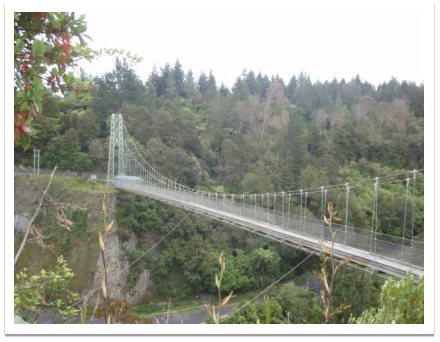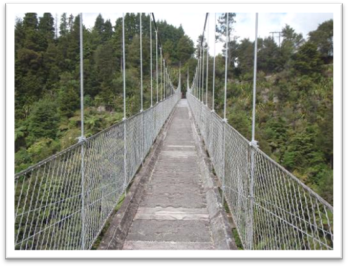HH-01: Arapuni Suspension Bridge

Date of Photograph: 29/10/2008
Location and Zoning Information | |
Address |
Arapuni Domain |
Current Owner |
Mercury Energy Limited |
Legal Description |
|
Zoning |
SPZ-ELG |
Valuation Number |
0541223500 |
Google Maps Link |
|
Architecture | |
Date of Construction |
1925-1926 |
Materials |
Concrete anchors and foundation; One concrete tower and one steel; steel cables; suspender rods and angles; timber joists & wooden decking. (HNZPT) 480-500 ft long. 320ft east end, 274ft west end above sea level. |
Architecture/Engineer/Builder |
Architect: Armstrong, Whitworth & Co Ltd (Newcastle) Builder: David Rowell & Co. Ltd of Westminster, UK. (HNZPT) |
Condition |
Good condition and high level of integrity. (HNZPT). Signs on the bridge limit the number of people crossing at any one time. Mercury Energy undertakes regular condition assessments, and reserves the right to close off the bridge for safety or maintenance reasons. (Mighty River Power, Feb 2001). |
Original Site Recommendation |
HNZPT Ref: 4168. Heritage Advisor, HNZPT. Additional information can be found in "The History of Arapuni" I.J. Southward. |
Current Use |
Recreation Suspension Bridge - pedestrian access. Enables view of Arapuni Powerhouse and electricity generation site. |
Statement of Significance | |
(1 Historical) - was associated with events, persons or ideas of importance in South Waikato history. Powerhouse associated with first state built hydro dam on Waikato River. Public works. (3 Community Association) - has important community association and public esteem, used by workers to gain access to powerhouse (and associated infrastructure) construction site. (6 Educational) - has the potential to educate public about the history of South Waikato, item on a heritage trail, school programme potential, study of technology. (9 Technological) - is an important example of construction using particular construction methods, was important in the development of technology, technological innovation or technological processes, ancillary structure that supported NZ's largest civil engineering project. Possibly shipped prefabricated. (11 Context) - forms part of a wider historical and cultural complex, Arapuni Power Station and township. Visual aspects that relate to history and setting. (13 Integrity) - has a good level of integrity, good condition, no additions or major alterations and an addition based on advice from HNZPT concerning these alterations. District Plan RulesDemolition -NC. Protection focus - 1, 6, 9 and 11. Mitigate the effects of demolition by requiring the applicant to provide Historical Building Documentation (HBD) which should include: the structure history, photographic documentation and measurements of the item prior to removal. Alterations necessary for the primary purpose of improving structural performance, fire safety or physical access –CON -Refer to HH-R2. Other Additions/Alterations –DIS. Protection focus - 9, 11 and 13. Repair of the Structure – PER. Refer to HH-R1. Protection focus - 6, 9, 11 and 13. Building Materials Rule: If repair of the structure is proposed theatricals used for the exterior walls and elements should be similar in type, dimensions and profile as the existing fabric of the building. Design Rule: Repair or replication work should match the existing design and profile of the element. Re-use/Change of Use - PER. Refer to HH-R1. Protection focus - 6, 11 and 13. Internal Changes - Not applicable. Relocation - DIS. Protection focus - 6, 11 and 13. Mitigate the effects by 1) Consultation with the community, and/or consultation with Iwi or special interest groups, 2) Relocate to a similar setting, 3) Documentation (HBD). Disturbance of the site surface/earthworks - Note: Any place that was associated with human activity prior to 1900 and is able to provide evidence relating to the history of New Zealand is an 'archaeological site' (refer to definition of 'archaeological site' in Section 2 of the Heritage New Zealand Pouhere Taonga Act 2014). All archaeological sites are protected under the Heritage New Zealand Pouhere Taonga Act 2014 and approval from Heritage New Zealand must be obtained prior to destroying, damaging or modifying any site. Accordingly, where this site on which a building is located is an 'archaeological site' and the building is to be repaired, added to, relocated or demolished and this involves disturbance to the surface and/or subsurface of the site, approval from Heritage New Zealand is required.
| |
History | |
Pedestrian bridge for use in association with dam construction. The suspension bridge has a span of 152m across the Arapuni Gorge one mile from the dam. Deck 1.2m wide and descends at a grade of 1 in 10 from the eastern bank of the river. The deck is approximately 50m above the water. It is an important ancillary structure to what was New Zealand's largest civil engineering undertaking at the time. Structure likely to have been shipped prefabricated from England and erected by British Contractors, Armstrong Whitford. It connected "Top Camp", eventually to become the permanent township of Arapuni, with the western side of the gorge. Top Camp accommodated workers employed on the construction of the spillway, power station, penstock and outdoor station. The bridge still provides essential access between Arapuni and the Hydro Electric installation. (HNZPT). In 1926, a pipe suspension bridge was constructed to convey water to the construction site, for access to the site by workers. The bridge still carries a water pipe that conveys potable water to the outdoor switchyard. The bridge also carries communications cables. (Mighty River Power, Feb 2001).
| |
Additional Photographs

